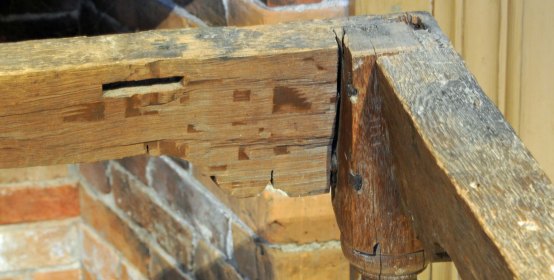I’ve been lots of places in recent years, but somehow hadn’t made it back to Vermont since 2003. So I combined a family trip with a research visit to Shelburne Museum in Shelburne, VT to see this square table. The museum is great, Maureen and the kids saw more of it than I did, but what I saw I really liked. Hope to get back before 15 more years go by…
The table is a great example, all oak, all riven. The feet have been worn and/or cut down, and as you see the top is missing. But what is there is very nice.
One of the first features is the integral brackets on the aprons, and the corresponding central scroll. Here’s one of the brackets, set off nicely by the ogee molding run along the apron.
This is the part along the center of each apron, essentially a back-to-back bracket. The total height of the apron is about 4 3/8″. The brackets are about 1 3/4″ of that height.
You can see the inside shoulders of the rails cut away, leaving as the only contact point the front shoulder. Makes a nice neat looking joint. Enlarge this photo and you can see some joint ID marks done with a narrow chisel, on the inside of the apron. This one is number IIII.
In addition so various peg holes, etc there are many channels dug by wood-eating insects. This damage was not done to the table, but to the timber before the joiner worked it. I think we found evidence of this on just about every part of the table. This view also clearly shows the brackets as integral to the rail, not attached with joinery and nails like many are…
The symmetrical turning on the stiles, a related but different turning is used on the stretchers.
All four stretchers are turned squares; some have the radial face forward, some have it upward. I was surprised by this…I expected them to all agree one way or another.
All four stiles are cut right through the joinery. There’s no step cut down on the tenon. Usually the mortise height here is not the full height of the apron. That configuration leaves the top of the stile “closed” so the joint doesn’t show. Once the top is fixed to the frame it doesn’t matter anyway. But another surprise. I expected otherwise…
another weird puzzle – what is this little block of riven oak nailed to one apron?
There’s several patched holes bored in the aprons’ upper edges. And there’s mortises like this in three aprons. Yes, three, not four. They look like sure-’nuff mortises, presumably for tabs that attach to the underside of the top. Or are they later additions? There’s no holes I could see in the stiles.
My thanks to Tom Denenberg and Katie Wood Kirchhoff from Shelburne Museum, they were very helpful. And Rob Tarule came to help measure and examine the table, it was fun to look at stuff with Rob again, it’s been a long time…










I was just wondering yesterday about 17th century oak tables, and this shows up today! Nice piece–interesting comments.
Is it possible that the block of riven oak is used along with the 3 mortises to help support the top? That’s assuming the riven block is on a side without a mortise. These museum visit subjects are excellent for those of us that cannot visit them, and are greatly appreciated. Thanks.
Great post for those of us that love the back side of furniture. Just curious, what is the protocol for waxing furniture once it’s in a museum setting. Or is the idea to leave it “as found”. Thanks!!
[…] Peter Follansbee Table Photos: https://pfollansbee.wordpress.com/2016/10/14/shelburne-museum-square-table/ […]